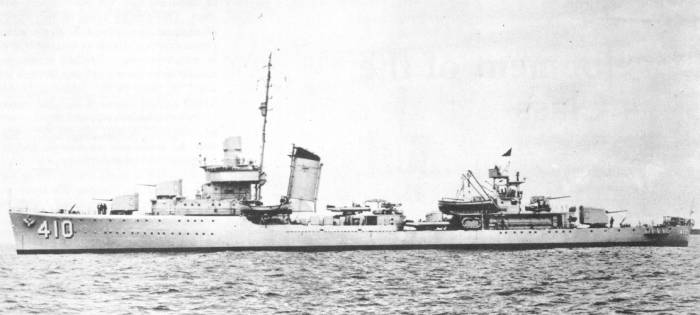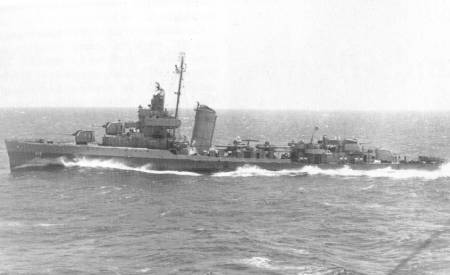

Design History
It was the Chief of Naval Operations who, in late 1935, asked that the fleet review the destroyer designs then in service or being built, in order to have its opinion on future design, and were told not to necessarily presume that the 1,500 ton limit on destroyer size from the naval treaties be in effect. Renewal of the naval treaties might, afterall, not happen.
The Bureau of Construction and Repair offered a number of new designs in March 1936. Considering that the only available means of improving ship survivability at this point was to use heavier, stiffer hulls, and to lessen the stresses on the hull. Other proposals aimed at using twin mounts for the main artillery, something precluded by the non-existence of such weapons. Neither of the four schemes which C&R proposed, for a variety of reasons, was entirely appealing. The Fleet, by an large, wished for the lighter gun, heavier torpedo armament approach. War Plans did not agree: Rear-Admiral Pye, the division chief, announced that the view held by the fleet was narrow; it did not take into account that although heavy torpedo armament was desirable at the point of contact with the enemy main fleet, the U.S. Fleet would likely have to engage many light units as it moved through the Pacific; and therefore, against the threat of Japanese destroyers, more guns, not more torpedoes, had to be the answer.
It was Pye's tentative design, close to Mahan with five 5" L/38 guns and either eight or twelve torpedo tubes that was selected and sent to the Secretary of the Navy for approval. This design, at 1,500 tons, was in effect a repeat Mahan, with the mentioned structural improvements. However, soon after the completion if this first draft, the Senate voted to approve the Second London Naval Treaty in May, 1936; which did away with the separate destroyer categories and only suggested that no ships with guns above 6.1" guns and 3,000 tons displacement could be considered "destroyers". Alas, with the advanced state of the new design, and a general unwillingness to start an entirely new design of larger proportions from scratch, only 70 tons were added to the Sims design.
Compared with the Mahan class, it bought the same armament of five 5" L/38 guns, six 12.7mm L/90 machine guns and twelve torpedo tubes, a stronger powerplant, a more durable hull, three enclosed gun mounts (No.s 1, 2, and 5), and a more capable gun director, Mk37, whose plotting room was in the hull of the ship, making for a lighter director and more safety for the plotting crew. Light armor plating around the pilothouse and the gun director was added for the first time in a U.S. destroyer. Furthermore, in an attempt to gain range, C&R performed extensive streamlining operations around the bridge structure.
Twelve Sims class ships were built, by six yards. The design agent was Gibbs & Cox of New York.
Service History
The Sims class ships remained in frontline service, serving with the North Pacific Force during the capture of Kiska and Attu, in 5th Fleet during the invasions of the Gilberts and Marshalls, and with 7th Fleet during the operations near Biak, Morotai, and in the Philippines. Russell participated in the final U.S. surface engagement of the war, sinking a Japanese destroyer off Manila in early January 1945. Operating off Okinawa and the Kuriles, the remaining Sims class destroyers ended the war with only one more incident occuring, the Kamikaze damage to Mustin. All ships were disposed of 1946 - 1948
Soon after the completion of the design of the Benham class, the Bureau of Construction of Repair began to reconsider the split that had been decided upon between 1,500 ton and 1,850 ton ships, mainly on account of Benham's considerable overweight. Realizing that little advanced could now be made on a displacement of 1,500 tons, and that the existing ships for their size were rather vulnerable, it would be very desirable to do something about that. Alas, anything even remotely resembling armor protection was impossible on any displacement then considered possible.
 Modification History
Modification History
The initial modification made to all Sims class ships was to the torpedo armament. Turning out to be decidedly top heavy, once completed, and given the requirements of their late-1940 in-service dates, the Sims lost one of their quadruple torpedo mounts, the other two now both being placed on the centerline. A modification made not much later put steel weather shields and a canvas top. Four additional 12.7mm L/90 guns were added, two replacing no.3 5" gun. At the end of 1941, the 12.7mm L/90 guns had been replaced by 20mm L/70 guns. At this point, all Sims class ships except Wainwright, Buck and Roe were transferred to the Pacific. Between 1941 and 1942, all ships were equipped with search and fire-control radar. Through 1943, twin 40mm mounts and fire-control units replaced the two 20mm guns placed in the position of the no.3 5" L/38 gun. For weight compensation, no.4 gun lost its weather shield. Three units, Mustin, Morris and Russell were equipped with anti-Kamikaze measures in 1945, removing all torpedo tubes in favor of two more twin 40mms. They were not completed before the end of the war.
Coming into service in 1940, the Sims class destroyers were immediately pressed into Atlantic service as convoy escorts and neutrality patrol vessels. After Pearl Harbor, however, all but Wainwright, Buck and Roe moved to the Pacific. These vessels participated in the invasions of North Africa and Italy. Roe was moved to the Pacific late in 1943, Wainwright in mid 1944. Buck
The Pacific destroyers, some of the most modern which the Pacific Fleet had, escorted carriers during the early war raids. Participating in the Battle of the Coral Sea, Sims was sunk, escorting the oiler Neosho, by a massive air strike. During the Battle of Midway, where several Sims class ships took part, Hammann was sunk with grave losses while tending to the damaged Yorktown. Staying with the carriers during the Guadalcanal campaign, the Sims class ships suffered another loss when O'Brien, escorting Hornet, was severely damaged by a submarine torpedo; she fundered near Samoa on her way back to the States for repairs. During the Second Naval Battle of Guadalcanal, Walke became the final Sims class victim, sunk by destroyer torpedoes.
Ships in class:
DD-409 Sims
DD-410 Hughes
DD-411 Anderson
DD-412 Hammann
DD-413 Mustin
DD-414 Russell
DD-415 O'Brien
DD-416 Walke
DD-417 Morris
DD-418 Roe
DD-419 Wainwright
DD-420 Buck
|
|
Displacements:
Standard: 1,759 tons Full: 2,477 tons Length: 106,15m / 348ft 3 1/8" Beam: 11m / 36 1 1/8ft Draft (Full Load): 4,07m / 13ft 4,5" Crew (Officers/Men): 10 / 182 Endurance: 3,660nm at 20 knots Speed: 35 knots |
|
|
Belt: No belt armor
Deck: No deck armor Barbettes: No barbette armor Conning Tower: No conning tower armor |
|
|
(As designed):
Main: 5 x 127mm L/38, in single mounts: two forward, superfiring, one in front of after deck house, two aft, superfiring Secondary: None AA: 4 x 12.7mm L/90 in single mounts Torpedoes: 12 533mm torpedo tubes in two quadruple mounts, two on the wings, on on the centerline Depth Charges: 2 x depth charge track, 10 depth charges (Hughes, October 1943):
(Wainwright, February 1945):
|